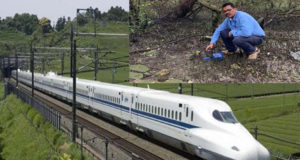
Ashis Sinha I Dhanbad: The scientists from CSIR-Central Institute of Mining & Fuel Research (CIMFR) are providing their immense support for the Mumbai-Ahmedabad Bullet train project.
The bullet train project will have 21 kilometres long underground corridor from BKC to Kalyan Shilphata in Maharashtra. Around 7 kilometres of this underground corridor is under the Thane creek while 1.8 km long section will be developed under the sea bed, while the remaining part of the stretch is to be built under the mangroves marshland on either side of the creek, official sources said.
CIMFR extended valuable contributions by contributing technical support. The scientist conducted a study and suggested mitigation measures to avoid any possible disturbance to flora and fauna and also provided technical supports on the impact of Tunnel Boring Machine (TBM) induced vibrations on Mudflat and migratory bird sanctuaries at the tunnel alignment of the Mumbai bullet train project, informed Dr. More Ramulu Senior Principal Scientist and Project Leader.
For the construction of the tunnel, National High-Speed Rail Corporation (NHSRC) required a scientific study to assess the effect of Tunnel Boring Machine (TBM) induced vibrations on the nearby Mangrove Creeks and Mudflats, where there are settlements of migratory birds, said Dr Ramulu adding “CIMFR was assigned to conduct a study and suggest mitigation measures to avoid any possible disturbance to flora and fauna.”
A team compromising of Dr. P.K. Singh, Director CIMFR, Dr. More Ramulu, Senior Principal Scientist & Project Leader, Dr. Partho B. Choudhury Senior Principal Scientist, Pushpedra Patel Technical Officer, Abdur Rahman and Banti Kumar Dhar Technical Assistant conducted a study there.
Experiments were conducted on ‘Rock Mass characterization by seismic profiling for assessment of vibration attenuation characteristics’ by generating surface waves along the tunnel alignment on the ground surface, said Dr Ramulu.
The surface wave attenuation characteristics helped to simulate the TBM vibrations and to assess the likely damage to Mangrove trees and Mudflats; Regression analysis was done for deriving a seismic wave prediction model and calculated possible TBM vibrations while tunnelling, he said.
CIMFR recommended restricting the Thrust Force of TBM to contain the vibration levels below threshold limits to ensure safety to Mangrove Creeks and Migratory birds settlements during tunnel construction below 20-meter depth, said Dr Ramulu.
“This scientific study is going to facilitate the NHSRC in getting environmental clearances from National Green Tribunal (NGT),” added Dr Ramulu.
EoM




